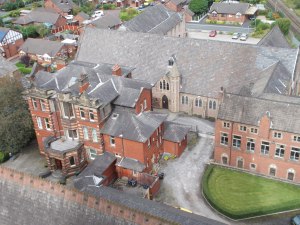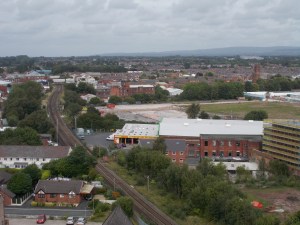 The site of St Walburge’s church is believed to be the location of a Medieval leper hospital, dedicated to St Mary Magdalene. Nothing now remains of this building, but what evidence do we have that it was located here ?
The site of St Walburge’s church is believed to be the location of a Medieval leper hospital, dedicated to St Mary Magdalene. Nothing now remains of this building, but what evidence do we have that it was located here ?
The general area around the church is called Maudlands. This is thought to derive from ‘Magdalene lands’, which itself comes from the leper hospital dedicated to St Mary Magdalene. We know for a fact that there was a leper hospital in Preston, because it’s mentioned in the historical records of the Lancashire Pipe Rolls in ‘letters of protection’ granted by King Henry II in 1177. From those documents we know that it had a warden and what were described as ‘leper brethren and sisters’ – presumably monks and nuns who tended the patients. The hospital also had a chapel and received donations of land from local benefactors.
A further letter of protection was granted by Henry’s son King John in 1206. The Magna Carta Project website publishes it in full, but only in its original Latin. Our Lancashirepast.com resident Latin expert has translated it as follows: “John, by God’s grace King of England, Master of Ireland and Duke of Normandy and Aquitaine with Anjou, to the archbishops, bishops, abbots, counts, barons, justices, sheriffs, and to all the ministers and loyal subjects, Greetings.
Know that the hospital of St Mary Magdalene, Preston and the lepers there are in our hands, care and protection, therefore we command that it, and the lepers and all their possessions, is maintained, protected and watched over, so that there is no injury, damage or disturbance done to them or permitted by anyone, and if anyone shall presume to do this they shall make amends without delay. This to do as stated in our father King Henry’s letters of patent which have been witnessed as reasonable. According to me at Chester, 29th February , in the seventh year of our reign”

The hospital’s seal still survives in the Fitzwilliam Museum in Cambridge. It shows Mary Magdalene holding a flowerpot in one hand and an ointment box in the other. It bears the legend SIGILLV: COMMVNE: FRATRVM: PRESTONE. Here at Lancashirepast.com we think this translates as “Seal of the Community of Brothers at Preston”. We were unable to find a picture of it, but here is a replica of a similar one for the St Mary Magdalene leper hospital at Bristol, which is preserved in the British Museum.
In the time of its second warden, John of Coleham, who served between 1270 and 1313, records survive of some of the donations given to the hospital by local people. William, son of William the Leech (described as a ‘medici’-so presumably a doctor) gave a grant of an acre of land in Preston. Margaret daughter of William Kibald gave six perches of land in a field in Tulketh. Most intriguingly, Robert son of Robert de Hunte of Thelwall gave a grant of a ‘villein, his issue and chatel’- presumably a man, his children and possessions ? To see more of these gifts to the hospital have a look at the Links section toward the bottom of this page.
The chapel was a site of pilgrimage especially on the feast days of St Mary Magdalene and St Thomas of Canterbury. During the Feast of the Invention of the Cross on May 3rd 1358 a riot broke out. The chapel was invaded by various people, including someone described as a Preston schoolmaster. The records of the Duchy of Lancashire Assize (court) tell us that some of the rioters were held as prisoners there for the next day.

By 1465 the leper hospital was no longer in use, but the chapel and its attendant lands were still a going concern. A similar situation seems to have happened at St Nicholas’s leper hospital at Edisford Bridge, in Clitheroe (see our page here). In 1525 the last chaplin, Thomas Barlow leased it and the lands to James Walton, who had to make sure that a mass for the King was said there once a week. He passed this obligation on to the local Franciscan Friars (of Friargate in Preston) along with leasing some land to them called ‘Widowfield’ . The Friars decided that they owned the land, and the History of the County of Lancashire tells us that ‘two friars and others forcibly entered the field’, causing him to appeal to the Chancellor of the Duchy. Seven years later he came under attack once more, this time the above mentioned volume states “the land was again seized by his opponents, who pulled down the mansion house attached to the chapel and carried off the ornaments of the chapel itself”.
After closing the monastries and stripping their assets, King Henry VIII sought to do a similar thing with the smaller independently owned chantry chapels. He sent his Chantry Commisioners out in 1546 to asses the value of each of these across the counry. They described the chapel of St Mary Magdalene as ‘defaced and open at both ends’ and as having ’58 acres of land’. It was dissolved two years later, and Henry’s son, King Edward VI gave what was described as the ‘Maudlands property’ to two London gentlemen, who soon sold it on.

The site of the graveyard from the leper hospital must be somewhere around the present day church of St Walburge. The Heritage England Pastscape website tells us that five skeletons and other human bones were found in 1836 when the new streets were being constructed in Maudlands. When St Walburge’s Church was built in the early 1850s a stone coffin and more skeletons were discovered, and similar finds of bones were located when the nearby Lancaster Railway cutting was made. Interestingly, at the site of Marsh Lane in the vicinity of the Franciscan Friary, a cemetery was discovered very recently and the bones of the occupants also showed signs of leprosy. For our full blog post on Preston’s Friary click here.
Today, nothing remains of the medieval leprosy hospital or chapel of St Mary Magdalene. But Maudlands is still an interesting place to visit, and on Saturdays St Walburge’s Church is open (see here), often with trips up to it’s famous tower, so why not go and view the vicinity for yourself ?
Site visited by A. and S. Bowden 2016
Access
St Walburge’s Church is on Westlands Street, Preston. It is open every Saturday, and as stated above, there’s often the facility to climb the steps of its very tall tower and survey the surrounding area.
Nearby, St Walburge’s Church
Just a short walk away the site of Preston’s Lost Medieval Friary
A little further away Craggs Row Windmill
A short drive away Preston Dock Curiosities
Links
To read more about gifts to the hospital of St Mary Magdalene, have a look at the National Archives webpage – click here
To read the letter of protection from King John written in Latin and to have a look at the Magna Carter Project website click here
References
The Magna Carter Project website : (accessed 18/9/16)
Historic England Pastscape Website:(accessed 18/9/16)
http://www.pastscape.org.uk/hob.aspx?hob_id=42498
The National Archives website detailing the Duchy of Lancaster Deeds (accessed 18/9/16)
http://discovery.nationalarchives.gov.uk/browse/r/h/C5687172
British History Online website(accessed 18/9/16) transcript of A History of the County of Lancaster Volume 2 edited by William Farrer and J Brownbill (1908):
http://www.british-history.ac.uk/vch/lancs/vol2/pp163-164
British Museum website. (accessed 18/9/16) The webpage about the St Mary Magdalene Leper Hospital Seal from Bristol:
The Wharncliffe Companion to Preston : An A-Z of Local History, David Hunt (2005), Wharncliffe Books
Comments are closed.